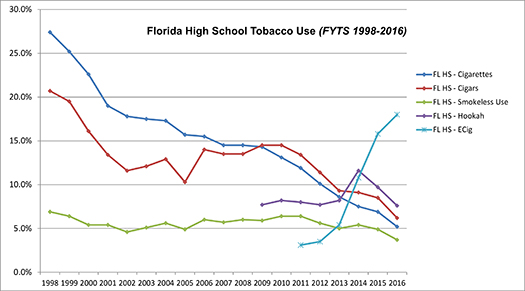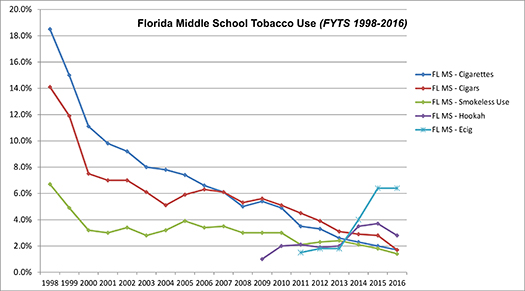News and Events
Youth E-Cigarette Use On the Rise in Florida
By Tracy DeCubellis
March 21, 2017
Electronic cigarettes, or e-cigarettes, are fast becoming a threat to the historically low use of tobacco products among Florida youth.
The e-cigarette was invented in 2004, making it a fairly new product on the market which has just recently come under state and federal regulations.
For over a decade e-cigarettes and other nicotine vaporizer products were on the market before any substantial regulations were enacted, including the way e-cigarettes were advertised. Florida law officially banned the sale of e-cigarettes to minors starting on July 1, 2014 and the Food and Drug Administration (FDA) initiated deeming regulations in 2016.
However, in the absence of marketing regulations, e-cigarette companies wasted no time following in the footsteps of traditional Big Tobacco, marketing by advertising their products in ways that especially appeal to youth. Flavors and colors were added to attract younger users. Music festivals, concerts and other events were sponsored by e-cigarette companies. Television and radio commercials, which are off-limits for traditional tobacco products, were used to send the message that e-cigarettes provide a cool, hip way for young people to “be free” or be more “adult”.
Apparently, young people were paying attention to these e-cigarette advertising campaigns. The 2016 Florida Youth Tobacco Survey (FYTS) results have been released and the data indicate a substantial increase in the number of young people who use e-cigarettes in our state. According to the 2016 survey results, 6.4% of middle school students are current e-cigarette users and 18% of high school students are current e-cigarette users.

The first year e-cigarette use was measured by the FYTS was 2012. Between 2012-2016, the percent change in e-cigarette use by middle school student was 300% and the percent change for high school students was 445.5%. The number of young Floridians using e-cigarettes continues to rise each year and the number is now more than three times higher than the number of youth who smoke traditional cigarettes.

This exponential rise in Florida youth e-cigarette use should be of great concern for several reasons. First, while the overall youth smoking rate has been reduced, youth are increasing their overall intake of addictive nicotine via e-cigarettes and vaporizer products. We will have a new generation of young people addicted to nicotine as a result of these new delivery systems. Secondly, since e-cigarettes are a very new product with no current testing process for the liquids, the long-term and short-term health effects are unknown.
Another issue is that new research shows e-cigarette use among young people leads to increased risk of smoking traditional tobacco (Miech et al., 2017). A nationally representative longitudinal study was conducted measuring e-cigarette use, or vaping, as a predictor of future cigarette smoking as well as attitudes about tobacco harm among high school seniors. The study concluded that “vaping [is] a one-way bridge to cigarette smoking among youth” (Miech et al., 2017, p.1).
The reason youth have a lower perceived risk of tobacco harm is related to experimentation with vaping and the lack of immediate health consequences from that activity. Young people then assume that the claims about tobacco harm may not be accurate based on their own short-term experience with vaping (Miech et al., 2017). Over the course of the survey, using e-cigarettes was a strong predictor that youth would also be smoking traditional cigarettes after 12 months (Miech et al., 2017). The researchers cite five additional previous studies which demonstrate similar results in that young people who use e-cigarettes are likely to initiate smoking traditional “combustible” cigarettes in the future.
Based on the evidence that is accumulating around youth e-cigarette use leading to traditional cigarette smoking, it is reasonable to hypothesize that the rise in e-cigarette use among Florida students may lead to the increased use of other forms of traditional tobacco use in the future.
In Gilchrist County, the FYTS data show a 589% increase in e-cigarette use among youth ages 11-17. This represents a change from 2.8% in 2012 to 19.3% in 2016. When we break down the data between middle school and high school student e-cigarette use, we can see that e-cigarette use among middle school students represents a 508.8% increase, and for high school students we see a 124.6% increase between 2012-2016.
Additionally, between 2014-2016 the following forms of current traditional tobacco use have increased among youth ages 11-17: cigarettes, cigars, smokeless, and hookah. It is reasonable to hypothesize that there is a correlation between the increased use of traditional tobacco products with the massive increase in youth e-cigarette use in Gilchrist County.
The trend of youth e-cigarette experimentation and regular use is on the rise. As adults, it is our responsibility to protect young people from nicotine addiction and the health issues that accompany its use, as well as the increased likelihood of traditional tobacco initiation. It is vital for the public health community and decision makers to act sooner rather than later to protect Florida’s youth from e-cigarette and vaporizer use to prevent them from being the next generation of tobacco users.
_____________________________________________________________________
References:
- Florida Department of Health. (2017). Florida Youth Tobacco Survey Report.
- Miech, R., Patrick, M.E., O’Malley, P.M. & Johnston, L.D. (2017). E-cigarette use as a predictor of cigarette smoking: Results from a 1-year follow-up of a national sample of 12th grade students. Tobacco Control, (0)1-6. doi: 10.1136/tobaccocontrol-2016-053291




